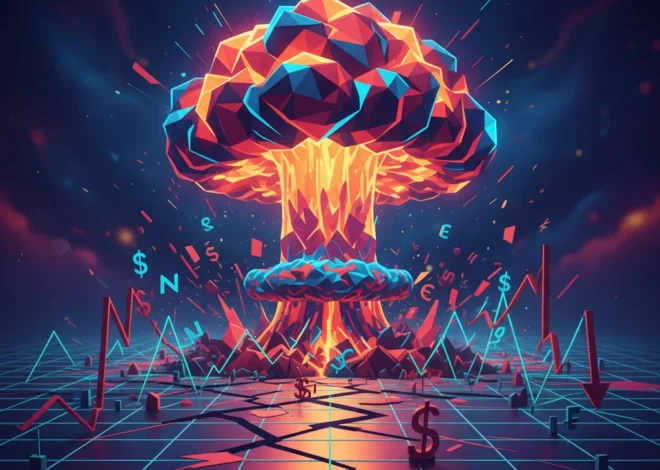
Beyond the Handshake: Decoding the Trump-Xi Trade Truce and Its Impact on Your Investments
In the high-stakes world of global geopolitics, few relationships are as scrutinized as the one between the United States and China. Every meeting, every statement, and every handshake sends ripples through the global economy, directly impacting the stock market and investment portfolios worldwide. A pivotal moment in this ongoing economic saga was the meeting between then-U.S. President Donald Trump and Chinese President Xi Jinping, where negotiations were rekindled amidst a tense trade war. Following talks in South Korea, President Trump praised his Chinese counterpart, calling him a “great leader” in what was seen as a significant de-escalation of rhetoric (source).
But for savvy investors, business leaders, and anyone with a stake in the world of finance, the real story lies beyond the diplomatic pleasantries. What did this truce truly signify? Was it a turning point towards a stable economic future, or merely a temporary pause in a much larger, structural conflict? This article dissects the implications of such high-level negotiations, exploring the underlying economic forces at play and offering a strategic roadmap for navigating the volatile intersection of politics and finance.
The Anatomy of a Trade Conflict: More Than Just Tariffs
To understand the significance of the Trump-Xi meetings, one must first grasp the complexity of the U.S.-China trade dispute. While headlines often focus on tariffs—taxes on imported goods—the conflict is rooted in deeper, more systemic issues that have been simmering for decades. The U.S. has long cited several core grievances:
- The Trade Deficit: For years, the U.S. has imported significantly more from China than it has exported, creating a massive trade deficit. While many economists argue that bilateral deficits are not inherently negative, the sheer scale of it became a major political focal point.
- Intellectual Property (IP) Theft: U.S. officials have consistently accused China of systematic IP theft and industrial espionage, costing American companies hundreds of billions of dollars annually. According to a 2017 report by The Commission on the Theft of American Intellectual Property, the annual cost to the U.S. economy exceeds $225 billion and could be as high as $600 billion (source).
- Forced Technology Transfer: American companies seeking to operate in China have often been required to form joint ventures with local partners, a process that frequently involves the forced transfer of proprietary technology and trade secrets.
- Market Access Barriers: U.S. firms have faced significant regulatory hurdles and non-tariff barriers that have limited their ability to compete fairly in the Chinese market, particularly in sectors like banking and financial technology.
China, on the other hand, views these U.S. actions as an attempt to contain its rapid economic ascent and technological advancement. From Beijing’s perspective, its policies are crucial for its national development and for moving its economy up the value chain, as outlined in industrial strategies like “Made in China 2025.” This fundamental clash of economic models and national ambitions is the engine driving the conflict, making any resolution far more complicated than simply adjusting tariff rates.
The State Strikes Back: Why the Nexperia Takeover Signals a New Era for Global Investing
Market Volatility: The Stock Market’s Reaction to Political Theater
For those involved in investing and trading, the U.S.-China trade narrative has been a primary driver of market volatility. The stock market often acts as a real-time sentiment gauge, with algorithms and traders reacting instantly to tweets, headlines, and official statements. A positive comment can send markets soaring, while a threat of new tariffs can trigger a sharp sell-off.
This dynamic creates an environment where political pronouncements can temporarily overshadow fundamental economic data. The table below illustrates the typical market reaction patterns to different phases of the trade negotiations, demonstrating the direct link between geopolitical events and financial market performance.
Illustrative Market Reactions to U.S.-China Trade News
| Trade Negotiation Event | S&P 500 Index (Illustrative Reaction) | Shanghai Composite Index (Illustrative Reaction) | Most Affected Sectors |
|---|---|---|---|
| Threat of New Tariffs Announced | -2.0% to -3.5% | -2.5% to -4.0% | Technology (Semiconductors), Industrials, Retail |
| Positive Talks Reported / Truce Agreed | +1.5% to +2.5% | +1.0% to +2.0% | Agriculture (Soybeans), Technology, Automakers |
| Negotiations Break Down | -3.0% to -5.0% | -4.0% to -6.0% | Global Supply Chain, Shipping, Manufacturing |
| Surprise De-escalation or Tariff Delay | +1.0% to +2.0% | +0.5% to +1.5% | Consumer Goods, Tech Hardware |
As the data shows, both U.S. and Chinese markets are highly sensitive, but the impacts are not uniform. Technology companies, with their deeply integrated global supply chains, are often the most vulnerable. Conversely, agricultural sectors may rally on news of a truce, hoping for a resumption of large-scale commodity purchases. This highlights the importance of a sector-level analysis for any investor looking to navigate this landscape.
The Global Ripple Effect: Beyond Wall Street and Beijing
The consequences of the U.S.-China economic conflict extend far beyond their borders, creating significant headwinds for the entire global economy. The International Monetary Fund (IMF) has repeatedly warned that trade tensions are a primary risk to global growth, citing disruptions to supply chains, dampened business investment, and increased policy uncertainty (source).
Key impacts on the global financial system include:
- Supply Chain Realignment: Companies are being forced to rethink their global supply chains to mitigate tariff risks. This has led to a shift in manufacturing to other countries like Vietnam, Mexico, and India, a costly and complex process that can create short-term inflation.
- Central Bank Policy: The uncertainty created by the trade war complicates the work of central banks like the Federal Reserve and the European Central Bank. They must weigh the inflationary impact of tariffs against the potential for an economic slowdown, making decisions on interest rates far more difficult.
- The Future of Global Banking: The conflict also poses risks to the global banking system. A significant economic downturn could increase corporate defaults, while escalating geopolitical tensions could lead to financial sanctions or restrictions on capital flows, challenging the integrated nature of modern finance.
Furthermore, this rivalry is accelerating the exploration of alternatives to the U.S. dollar-dominated financial system. China’s development of a digital yuan (e-CNY) and the broader rise of blockchain-based financial instruments represent a long-term challenge to the existing order. This push towards new financial technology is, in part, a strategic move to create payment systems that are less susceptible to U.S. influence and sanctions.
Beyond the Shadows: Why It’s Time to Retire the Term 'Shadow Banking'
Actionable Insights for Investors and Business Leaders
Navigating this complex environment requires more than just passive observation. It demands a proactive and strategic approach. Whether you are a CEO managing a global corporation or an individual investor managing your retirement portfolio, the principles of resilience and diversification are paramount.
For Business Leaders:
- Diversify Your Supply Chain: The era of relying on a single country for critical manufacturing is over. Building redundancy and geographic diversity into your supply chain is no longer a choice but a necessity for risk management.
- Scenario Planning: Actively model the potential impact of various trade policy outcomes, from full-scale deals to further escalations. Stress-test your financial forecasts against these scenarios.
- Focus on Innovation: In an era of technological competition, investing in R&D and protecting your intellectual property is more critical than ever. This is a key battleground in the broader U.S.-China conflict.
For Investors:
- Geographic Diversification: Don’t be overly concentrated in any single market. A well-diversified portfolio should have exposure to different economic regions to mitigate country-specific political risks.
- Focus on Quality and Resilience: Favor companies with strong balance sheets, pricing power, and business models that are less dependent on fragile international supply chains. Companies with strong domestic demand may be better insulated from trade disputes.
- Understand Your Exposure: Dig deeper than the headlines. Analyze how the companies in your portfolio are specifically exposed to tariffs and the Chinese market. A U.S.-based company with significant sales in China is just as exposed as an importer.
Economic Warfare: Unpacking the US Sanctions on Russia's Energy Giants
Conclusion: A New Paradigm for the Global Economy
The meeting where President Trump hailed President Xi as a “great leader” was a classic example of the volatile diplomacy that has come to define modern U.S.-China relations. It offered a temporary reprieve to nervous markets and a glimmer of hope for a negotiated settlement. However, the fundamental disagreements on economics, technology, and global influence remain firmly in place.
For everyone from the finance professional to the everyday investor, the key takeaway is that geopolitical risk is now a permanent and significant factor in market dynamics. The handshake was a single moment, but the underlying trends—technological competition, economic rivalry, and the re-writing of global trade rules—will shape the investment landscape for the foreseeable future. Success in this new paradigm will not come from predicting the next political move, but from building resilient, diversified, and strategically sound portfolios and businesses that can withstand the inevitable turbulence ahead.


